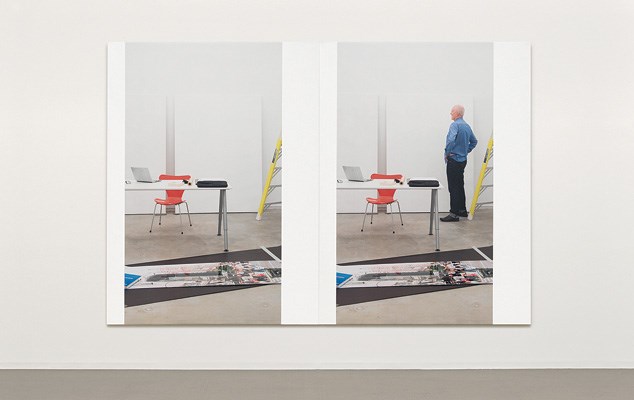This is really Vancouver art. Im not making a big thing about it, but the unique esthetic of the city and its people comes through in the work.
Artist Ian Wallace is speaking by phone from the East Vancouver studio hes occupied since 1985. Hes repeating what he told a tour of Vancouver Art Gallery docents just a few days before. The tour went two hours longer than planned, he says he simply had so much to say about the work, spanning over 40 years, now on display.
Ian Wallace: At the Intersection of Painting and Photography explores the internationally renowned artists creative journey from the 1960s to today. From an experimental slide show (Poetry Must be Made by All) to elaborately staged, large-scale photographs (Lookout) and many works that combine photographs and abstract painting (Clayoquot Protest, At the Crosswalk), the exhibit documents Wallaces preoccupations with cinema, urban landscapes and the process of making art.
Steely downtown Vancouver is the subject of many of Wallaces large photographs, but the artist says his formative years in bucolic West Vancouver played a big part in his development as an artist. In 1954, Wallace, then 11, moved with his parents and four younger brothers to what was at the time the top of West Vancouver.
From our house down to the water was people and West Vancouver, from our house up above was wilderness, says Wallace. There was this total kind of contrast between the wilderness and the mountains what we always called the bush and the town below.
Wallace remembers going into the bush in the morning and not coming home until dinner time.
We used to build our own little gold rush town... It was very worked out with costumes and everything. Wed have all these narratives, wed have robberies and chase each other through the woods,
Encouragement of the arts at his high school and incredible teachers also played a role.
The atmosphere in the school was great, says Wallace. There was real encouragement, even though there were no real resources.
Wallace says that hijinks got him kicked out of an industrial drafting class; as punishment, he was sent to the art class, where he specialized in drawing portraits of pretty girls. He also published cartoons and poetry in the school newspaper.
When he moved out of his mothers house after high school, it was into an old house at Robson and Burrard then an epicentre of beatnik culture with two classmates who were also aspiring artists, Terry Reid and King Anderson.
I followed them into beatnik territory, laughs Wallace. (His brothers Ken and Keith also work in the art world, Ken as a painter and Keith as a curator.)
There was also the Question Mark a club at 15th Street and Marine Drive in West Vancouver where jazz or poetry were on offer almost every night of the week.
While Wallace was interested in poetry, filmmaking and playing jazz, art is where he finally settled, although he has continued to bring elements of those other art forms into his work. On the first floor of the exhibition, which deals with his earlier work, film stills from Jean-Luc Godards Masculin-Feminin make up one piece. Poetry and text are incorporated into other works.
On the second floor, Wallaces interest in urban landscapes, institutions such as museums and the artists studio as a place of work are on display. Many of the pieces are large photographs, which incorporate abstract paintings. In his At the Crosswalk series, two city dwellers on opposite street corners are separated by stark painted blocks in the centre of the photograph. Dwarfed by the office buildings in the background, the people also seem to be separated by an insurmountable gulf.
Im rescuing painting from oblivion by making it the ground for the photograph, states Wallace, moving into art history mode, a subject he taught at UBC in the 1960s and 70s.
He explains that he incorporates painting with photography as a way to merge the more highbrow medium of painting with the more common, found-everywhere photography.
Everybodys telephone has a camera, Wallace points out.
Photography and film took over where paintings used to hold sway, providing realistic portraits of important cultural moments and stories. Abstract art and Cubism were responses to this, says Wallace. For him, merging the two media is his way of maintaining values about humanity, subjectivity and who we are as individuals.
After decades of depicting urban life, Wallace is now thinking about using the bush as subject matter. The retrospective exhibition has given him an opportunity to reflect on his body of work. But he hasnt finished adding to it yet.
Ive got a lot of things in my backpack waiting to be unloaded, says Wallace.
jstdenis@nsnews.com
Ian Wallace: At the Intersection of Painting and Photography
At Vancouver Art Gallery until Feb. 24
750 Hornby St.
Ph. 604-662-4700
vanartgallery.bc.ca



